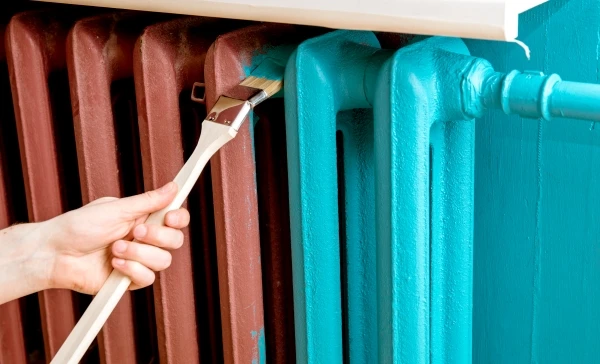How to Paint a Radiator Safely

While they certainly serve a purpose, radiators can become somewhat of an eyesore in a room. This is especially true if your radiator happens to be a color that clashes with your home décor. Thankfully, painting your radiator is an easy option that can help make it blend in with the rest of its surroundings. While you could always hire professionals for the job, radiator painting is a job you can complete yourself with a little planning and preparation.
How to Paint Your Radiator and Radiator Pipes
The very first step to painting your radiator is to turn it off. Once it has cooled down, clean it thoroughly. To do this, fill a bucket with hot water and add a little dish soap. Wring out the sponge or rag you are using, and then scrub the entire surface of the radiator, using the rough side of the sponge to get off any stubborn dirt or grime. Then, use a towel to thoroughly dry the radiator. After your radiator is sparkling clean, open a couple of windows in the room for ventilation. Then follow these steps to paint:
-
To begin painting, your radiator must be off and completely cold. Even a little bit of warmth could interfere with the paint application.
-
Using sandpaper or a sanding block, gently sand the surface of your radiator to remove any loose paint or debris. This will also help the new paint bond better to the surface. When finished, use a cloth to gently clean the surface and remove any dust.
-
Using a paintbrush, apply a coat of primer. It is best to use a radiator-specific primer, or a primer made for hot metal surfaces. If you opt for a primer spray instead, be sure to hold the can of primer at least 6 to 8 inches away from the surface of the radiator (and make sure you have good ventilation).
-
After your primer coat is completely dry, it’s time to paint. Using your paintbrush (you can also use spray paint), use long strokes going in the same direction as the grooves of your radiator. This will ensure a nice, neat finish. You may want to paint in sections for a more even coat.
-
After the first coat of paint has dried, examine your work to see if a second coat is necessary. With lighter colors, you may be able to get away with one coat. However, darker colors almost always require two coats.
Radiator Painting FAQs
What Paint Do You Use on Radiators?
Any paint formulated for hot metal surfaces is ideal. If you really want a great-looking finish, the best way to paint a radiator is to spray the paint. However, this can require moving the radiator away for a wall, which isn’t always an option. In addition, spraying paint creates air borne particles that can be harmful without proper ventilation.
Can You Tell Me How to Paint Behind a Radiator?
There are special tools in your local hardware store that make it easy to paint behind radiators. They are inexpensive, easy to use, and offer the best way to paint behind radiators, toilets, and other hard-to-reach areas.
Can You Use Wall Paint on Radiators?
Although you can use wall paint on your radiator, you’ll get much more durability using a heat-resistant paint made for metal surfaces. If you decide to go with wall paint, just keep in mind that it may begin fading, chipping, or flaking within a couple years. Radiators get quite hot frequently, and heat-resistant paints are designed to withstand high temperatures.
Can I Paint My Radiator with Gloss Paint?
As long as the paint is formulated for hot metal surfaces, you can use whichever paint finish you’d prefer.
Need Help from the Pros?
Although painting a radiator is not complicated or difficult DIY project, you may not have the time or patience to do it yourself. The pros at your local Five Star Painting can help you with any other painting projects around your home. We offer high quality interior and exterior painting services that can change the look and feel of a few rooms, or an entire house. To learn more give us a call at (888) 261-3633 or request a free estimate online today!
 Click to call
Click to call




